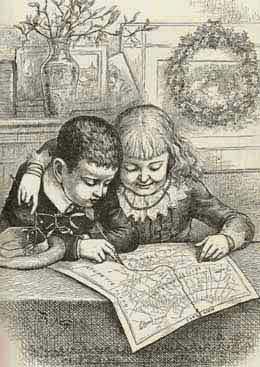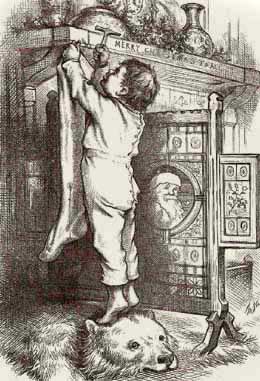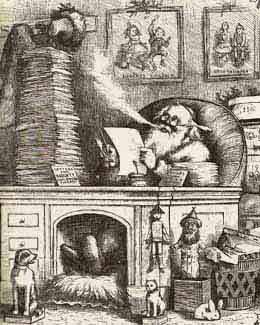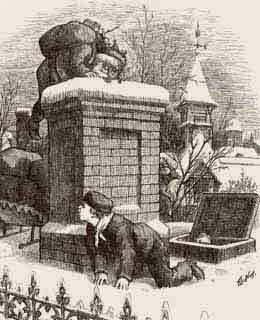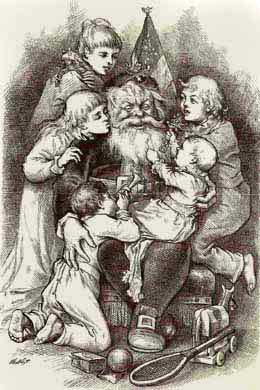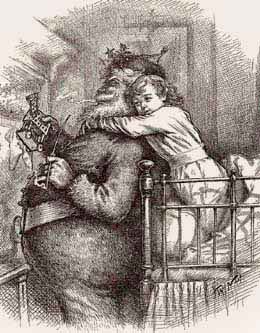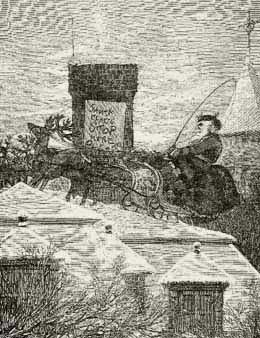pop up description layer
HOME
Cryptozoology UFO Mysteries Aviation Space & Time Dinosaurs Geology Archaeology Exploration 7 Wonders Surprising Science Troubled History Library Laboratory Attic Theater Store Index/Site Map Cyclorama
Search the Site: |
|
The Christmas Visions of Thomas Nast
At the beginning of the 19th century Santa Claus found himself in a quandry. What should he wear? Perhaps he should emphasize his title of St. Nicholas and appear as a stern bishop wearing robes? Or maybe go the other way and be seen as a clowning elf with a frock coat and pantaloons? It was at this point that Thomas Nast, premire American political cartoonist of the 1800's, stepped in and gave Santa the well-needed makeover that he still carries with him even today... Thomas Nast was born in Germany in 1840 where his father was a muscian in the Ninth Regiment Bavarian Band. When he was still a child his family immigrated to New York City. His father noticed that young Thomas had a flair for drawing and for a short while he was sent to study at an art school. At the age of 15, when family funds for the school were exhausted, Nast precented himself to Frank Leslie, owner of the journal Leslie's Illustrated, hoping for a job. Leslie, not wanting to be bothered with the boy, gave him a difficult assignment: sketching the crowd at the Christopher Street Ferry. Nast, however, turned in a drawing that was so fine that Leslie hired him on the spot. In 1859 Nast started drawing for Harper's Weekly, a relationship that would last for more than twenty-five years. Nast became a war correspondent first covering Giuseppe Garibaldi campaign to liberate Italy from Austria in 1860. When he returned to America in 1861 Nast found the country embroiled in the Civil War and traveled to the war front to record battles scenes. His support of the war with his patriotic drawings led President Lincoln to refer to him as the "Union's best recruiting sergeant." General Grant also acknowledged that Nast and his pen had done as "much as any man" to bring the war to an end. After the war Nast was a journalistic crusader, swinging a pen rather than a sword. His biting political cartoons took on civic dishonesty and corruption whereever he found it. Despite death-threats Nast and Fletcher Harper (owner of Harper's Weekly) managed to bring down the notorious politician "Boss" William Marcy Tweed of Tammy Hall whose crime ring was bleeding the city of New York dry. It is estimated between 75 to 200 million dollars disappeared illicitly into the ring's hands in the years following the Civil War. Tweed complained that he didn't care much what the papers wrote about him because his constituents couldn't read, but they did understand Nast's pictures. When Tweed died in prison in 1878, every one of Nast's cartoons criticizing him were found in his possession. During his heyday Nast took on anybody he did not agree with: the Ku Klux Klan, anarchists and dishonest politicians. He also had causes he supported with his art, including voting for blacks, rights of the Native Americans and wildlife conservation. By 1879, however, Nast's infuence had reached its peak. Changes in the Harper's management led to the severing of the relationship after 1886. Over the last few decades of his life Nast found himself in debt due to bad investments. In 1889, however, old friends of his from Harper's suggested he gather his popular Christmas drawings into a single book which was published under the Harper banner as Christmas Drawings for the Human Race. Some might find it ironic that a man that had generated so much political controversy and anger during his career should be remembered for his drawings that captured the essence of peace on Earth and goodwill toward men, but perhaps it is because they reflect more the personal side of Nast including his love for his wife and family. Nast's children appear in the drawings and many of the settings are from the Nast home in Morristown, New Jersey. Nast's work captures the spirit of Clement Moore's famous poem, The Night Before Christmas, perfectly. Not only did Nast reflect Clement's thinking, but Nast also added to the Santa lore by creating such traditions as the existance of a toy workshop located at the North Pole. His art pictures a child's Christmas inluding toys that were popular at the time: toy soldiers, wooden animals, jack-in-the-boxes and dolls. Nast also drew on the Christmas traditions of his native land, Germany by combining the image of St. Nicholas, a fourth-century bishop, with German folk tales of elves to produce his 1862 version Santa: a rotund, little man with beard and mustache. Despite the success of Christmas Drawings, Nast was still in debt at the turn of the century. In 1901 Theodore Roosevelt was elected as President and, wanting to do something for Nast, appointed him Consul General in Ecuador. It was there in 1902 he died from yellow fever, though after having paid off the debt that so bothered him in the final years of his life. Nast's Christmas vision, however, is still with us more than a century after his death. It is a vision filled with nostalgia for traditions that have lasted generations and will continue as long as there is a Christmas. Copyright Lee Krystek 2005. All Rights Reserved. |
|
Related Links |
|
|



